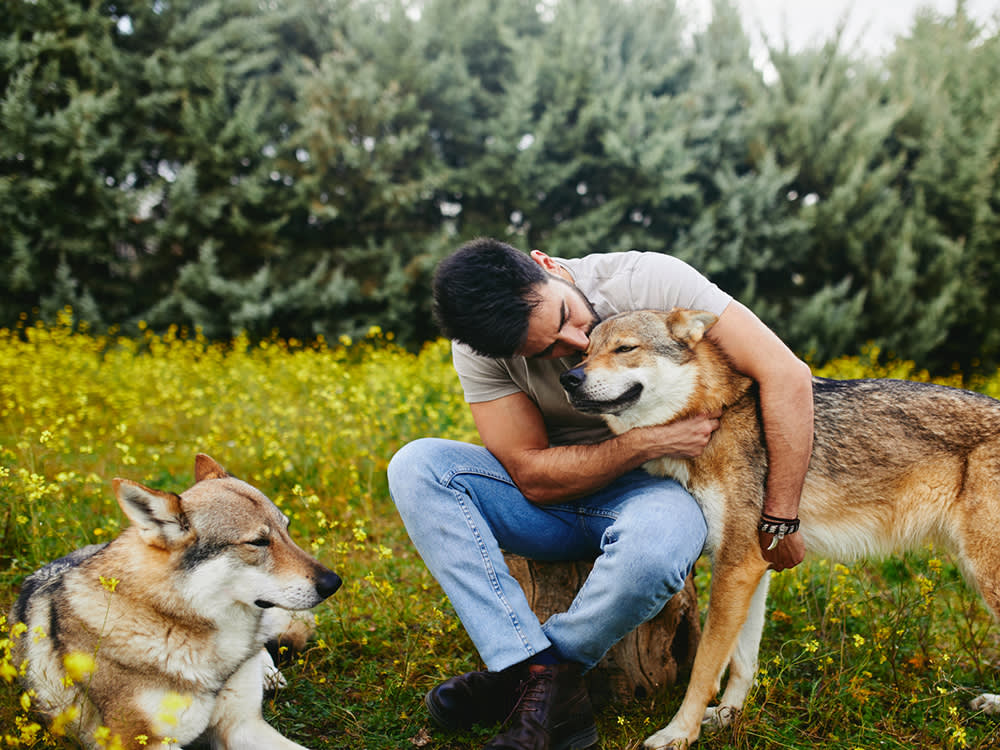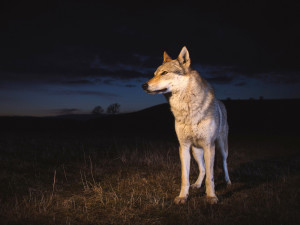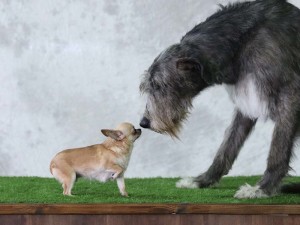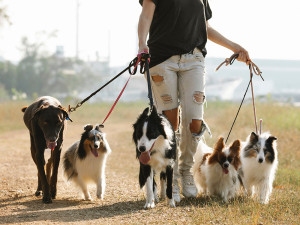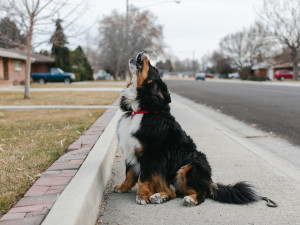Do Wolfdogs Make Good Pets?
Experts say these hybrid animals should be wild and free.
For centuries, wolves — incredibly charismatic, highly social and extremely intelligent — have held a special place in our consciousness, starring in as many nightmares as they have in paintings and pop songs. With their bigger brains, stronger muscles, and teeth and jaws many times more powerful than any dog’s, they’re also quite dangerous, capable of killing an elk, a moose, even a bison.
It’s both understandable and surprising that people want to take a bit of that wildness home in the shape of a wolf/dog mix — or “wolfdog” — which some consider to represent the best of both worlds: a dog’s friendly companionship paired with a wolf’s good looks and untamed nature. Buy a wolfdog, the thinking goes, and live out your Jack London fantasies, even if you’re in Akron rather than Anchorage.
Wolfdogs as Pets
As with many things, the reality is not so simple. Wolfdogs are perhaps the most misunderstood — and, many would argue, mismanaged — animals in America. Advocates of wolfdogs say they can be wonderful pets, while opponents argue that they’re unpredictable, untrainable, and inherently dangerous. They’re permitted in some places, forbidden in others and are showing up on breed ban lists, along with Pits and other so-called “dangerous breeds.”
How much do you spend on your pet per year?
What’s more, there’s no approved rabies vaccination for wolfdogs. While the federal government officially sees them as domestic pets (and leaves their regulation to individual states and municipalities), they’re treated as wild animals when it comes to rabies. So, a wolfdog who bites a person can be considered a rabies risk — even if they’ve been vaccinated. The USDA, which regulates veterinary medicines, does not extend approval for the use of the standard rabies vaccine with “hybrids” (the vaccine is approved for use in dogs, cats, ferrets, and horses). Euthanasia is necessary, the USDA says, because the only reliable test for rabies requires an examination of the animal’s brain.
Those with wolfdogs are encouraged to vaccinate their animals, but to do so, they have to make a tough choice: lie to their veterinarian about the animal’s lineage or sign a waiver stating that they understand that the vaccine is being used “off-label” on a hybrid animal and thus cannot be relied upon to deliver full protection against rabies, and that their animal can be impounded and put down if it bites someone — a high-stakes gamble, and one for which could prove fatal for the wolfdog.
Are Wolfdogs legal?
On the federal level, wolfdogs are legal, as they are considered domestic animals — but when it comes to their state and local legal status, the regulationsopens in new tab are literally all over the map. It’s illegal to keep a wolfdog hybrid as a pet in twelve states, including Connecticut, the District of Columbia, Georgia, Hawaii, Illinois, Massachusetts, Maryland, Michigan, New York, Pennsylvania, Rhode Island, and Wyoming. However, in Michigan, a wolfdog can be “grandfathered” in.
Wolf dog restrictions even in legal states.
In many other states, wolfdog ownership is regulated at the county level, so local laws will determine if wolfdogs are legal. Wolfdogs are covered by local laws in Alaska, Arizona, Arkansas, Colorado, Indiana, Iowa, Kansas, Louisiana, Minnesota, Montana, Nebraska, Nevada, New Hampshire, New Jersey, New Mexico, North Carolina, Ohio, Oklahoma, Oregon, South Carolina, Tennessee, Texas, Utah, Vermont, Washington, West Virginia, and Wisconsin.
But, even in the states that allow wolf hybridsopens in new tab, many require a permit or mandate registration, require vaccinations, veterinary certificates, and confinement in specific kinds of cages. In some states, that means getting a “dangerous animal” permit — the same type needed to keep a lion. And some regulations are based on the wolf-content levels, for example, in California, only first-generation wolfdogs are illegal.
“These are beautiful animals, and a lot of people are attracted to something that’s exotic and different,” says Nicole Wilde, a wolfdog expert and author of Wolfdogs: A–Z. “They want to own a piece of the wild, and they often say that the wolf is their spiritual sign or totem animal. Unfortunately, they don’t realize that it’s not really the same thing as having a wolf in their living room.”
Wolf dog or wolf like dog?
Wolfdogs can be tough to identify, regardless of laws passed to limit them. Several years ago, the USDA released a report estimating that there were about 300,000 wolfdogs in the U.S.; how they came to this metric is unclear, as the numbers are impossible to nail down. Some people deny their pets’ heritage, while others claim their 100 percent dogs are part wolf.
Many would believe a wolfdog is a mixed breed created by mating a regular dog (typically a German Shepherd Dog, Siberian Husky, or Alaskan Malamute) with a wild wolf to produce a wolfdog hybrid, but that’s not usually the case. In fact, experts say that the vast majority of animals sold (or bragged about) as wolfdogs actually possess very low wolf “content,” or none at all.
Who Defines a Wolfdog?
Part of the problem is that there’s no clear definition of what a wolfdog is, says Nancy Brown, director of Full Moon Farmopens in new tab, a wolfdog rescue and sanctuary in Black Mountain, N.C. Most experts use the term wolfdog to describe an animal with a pure wolf in its family, no more than four or five generations back. But there’s no way of proving any animal’s pedigree, as there is no breed registry (and no such thing as “papers” for a wolf or wolfdog, no matter what those who breed them contend).
Genetic testing is theoretically possible but, as it is often reserved for wildlife management and law-enforcement agencies, is essentially unavailable to most individuals and, importantly, not 100% accurate. Phenotyping — having an expert evaluate an animal’s physical and behavioral characteristics — remains the most accessible way to identify a wolfdog. Unfortunately, few are trained in phenotyping wolfdogs, and, as a result, many dogs are erroneously labeled.
Complexities of DNA
Even if you could draw its family tree, there’s no way to predict an animal’s “wolfiness,” says Stephen L. Zawistowski, PhD, former executive vice president and science advisor for the ASPCA. “I’ve seen ads for animals that are ‘98 percent pure wolf,’ but these are bogus numbers,” he says. “These claims are based on the misguided belief that genes blend like food coloring: if you take half red and half blue, you get a nice, even purple.” In reality, he says, genes “blend” more like marbles. Say you have a dog, represented by 20 red marbles, and a wolf, represented by 20 blue ones. If you breed the two, you’ll get 10 marbles from each parent, so you’ll have half of each color; this is an F1 (Filial 1, or first filial generation) cross. But in subsequent generations, you’ll get a random assortment of red and blue from each parent. So the individual offspring of two F1, 50/50 wolfdogs (an F2 cross, a generation removed from full wolf) could have anywhere from three-quarters wolf genes and one-quarter dog genes to three-quarters dog and one-quarter wolf — yet all will be considered one-half wolf. Ultimately, he says, you can see enormous variations among wolfdogs, even those from the same litter.
Knowing an individual animal’s filial number — the number of generations it is removed from a pure wolf — is probably the best way to speculate about its future behavior and potential problems, says Kim Miles of the Florida Lupine Association, a wolfdog advocacy group. “Wolfdogs aren’t easily pegged because they’re essentially a combination of wild and domesticated animals.” According to Miles, the biggest difference between a wild and a domestic animal is its tractability or the ease with which it can be managed or controlled. “A dog is like a 12-year-old child, and a wolf is like a 35-year-old man. The dog will generally do what you want it to, but the wolf will do what you want only if they want to do it themself.”
Mislabeled Mixed Breeds
Experts agree that the vast majority of wolfdog breeders are selling “high content wolfdogs” with little or no wolf content, despite the fact that the animals fetch as much as $2,500 apiece. Moreover, the majority of “wolfdogs” being kept as pets — and being surrendered to shelters and wolfdog sanctuaries — are all dog, too. “I’d say about 70 percent of the so-called ‘wolfdogs’ out there are not wolfdogs at all,” notes Ken Collings, former president of Wolfdog Rescue Resources, Inc., a national rescue organization headquartered in Stafford, Va. “Individuals take Malamutes, Shepherds, and other dogs and cross-breed them until they get an animal who looks like a wolf. And because most people [who want a wolfdog] are uneducated [about them] and have no idea what they’re looking at, they buy it.”
Unfortunately, people who like the idea of owning a fearsome predator, as well as those with a misguided nature fetish, often don’t understand what they’re getting into. In many cases, a person will think they have had experience with wolfdogs in the past — maybe they had or thought they knew a hybrid, but it was, in fact, all dog — and decides to get a wolfdog puppy. “Only this time, they get the real thing,” Collings says. “And by the time the pup is five or six months old, they’ve eaten the couch or clawed their way through the drywall.”
Of course, not all wolfdogs behave the same way, and there’s probably more variety in behavior among wolfdogs than any other kind of dog. “You have to remember that a wolfdog is not a wolfdog is not a wolfdog,” says Brown. “There’s no such thing as ‘typical.’”
Not for Most Dog Pet Parents
“A high-content wolfdog is probably going to act a lot more ‘wolfie’ than a low-content animal,” adds Wilde. “With a high-content wolfdog, you might start out with the puppy in the house and then, as he hits adolescence, you’ll be building an enclosure outside. You’ll have to.” It’s for just these reasons that many experts, including Wilde, discourage people from breeding wolfdogs or buying wolfdog pups from breeders.
In early 2015, media sources began to blame Game of Thrones for idealizing wolfdogs. Apparently, people trying to replicate a fictional experience at home were seeking out dogs with wolf content. Many of these people learned that caring for a wolfdog is nothing like living with a domesticated dog. Wolfdogs pose significant behavioral challenges for pet parents, many of whom are unable or unwilling to meet them, thus creating a large population of unwanted animals who wind up chained in backyards, abandoned to overburdened wolfdog sanctuaries, or euthanized.
“The average dog parent won’t deal with their Beagle and can’t handle an ordinary dog’s behavior problems,” says Wilde, who rescued a wolf and two wolfdogs several years ago. She can personally attest to the challenges of keeping these beautiful canines. “I worked with them to the point that I could look between their paw pads and look at their teeth — and give them tummy rubs — but I never forgot what they really were.”
Potential Wolfdog behavior problems
Experts have determined that wolves and dogs share more than 99 percent of their DNA, but those few strands make a big difference. As a wild animal, a wolf must be self-sufficient, capable of finding (and killing) prey, fending off enemies, and generally preserving its own life — essentially the opposite of what you want in an animal who’s sharing your home. Wolfdogs may display any or all of these behaviors to one degree or another, including:
Wolfdogs may have a high-level curiosity.
Wolves are constantly exploring their environment, says Frank Wendland, former executive director of the WOLF Sanctuaryopens in new tab in La Porte, Colo. In the wild, that means knowing every inch of a territory that can comprise from 50 to 1,000 square miles. In your house, that means knowing what’s inside everything, including the cabinets, appliances, and furniture. “Wolfdogs have to investigate,” he says. “We have a TV on the wall of our office, and I’ve seen them go into the adjoining room to see where the image is coming from.” Quite often, this exploration is done with teeth and claws. “I’ve seen them shred barbecues, walls, sofas,” he says.
Wolfdogs may have the drive to roam.
Hard-wired to guard their turf against other packs as well as intruders of other species, they’re also wide-ranging creatures and, in the wild, have been known to cover up to 30 miles a day. A wolf’s genes tell them to hit the road (and get out of any enclosure they’ve been put into) and defend their territory. Wolves also mark their territory with urine more frequently and copiously than dogs do.
Wolfdogs may have a propensity toward den-building and digging.
They can destroy your lawn (and furniture) in the same exercise and can also dig several feet down in order to escape from an enclosure. The starting cost of creating a safe and secure wolf dog hybrid enclosure is $3000 — not including construction — and that’s on the low end. The minimum space and confinement size requirements for wolfdogs vary by area, with some as low as 50x50,’ but space up to one acre is recommended for wolf hybrids.
Wolfdogs may have a strong predatory instinct.
A wolf looks at other animals (with the exception of other wolves) as dinner. Pet wolfdogs often make short work of cats and small dogs and may also attack bigger animals, so it is not recommended that they have access to small animals, including other dogs.
Unfortunately, that drive can also be directed at humans, making them dangerous; children are especially vulnerable. “A small child is really just about the size of a sheep or a fawn — bite-size,” Zawistowski says. “And that small stumbling animal triggers the predatory behavior.” In the wild, a wolf would never be close enough to a child to have that instinct triggered, he says. But wolfdogs are regularly kept in homes with kids, with occasionally tragic results. Wolfdogs should never be left unsupervised with small children.
“Wolves tend to avoid people, as most wild animals do,” says Zawistowski. “They have the ‘fight or flight’ thing, and most of the time, they choose flight. But when they fight, they’re really, really good at it.”
Editors’ Note: In our opinion, despite their undeniable beauty and appeal, deliberately breeding or purchasing wolfdogs as companion animals does a disservice to both Canis lupus and Canis lupus familiaris as well as to the individual animal. If you love wolves, honor their ancient connection with our domestic dogs by joining the effort to preserve their habitat and maintain their status as a federally protected species. HSUSopens in new tab and the Defenders of Wildlifeopens in new tab are just two of many groups working on their behalf.
